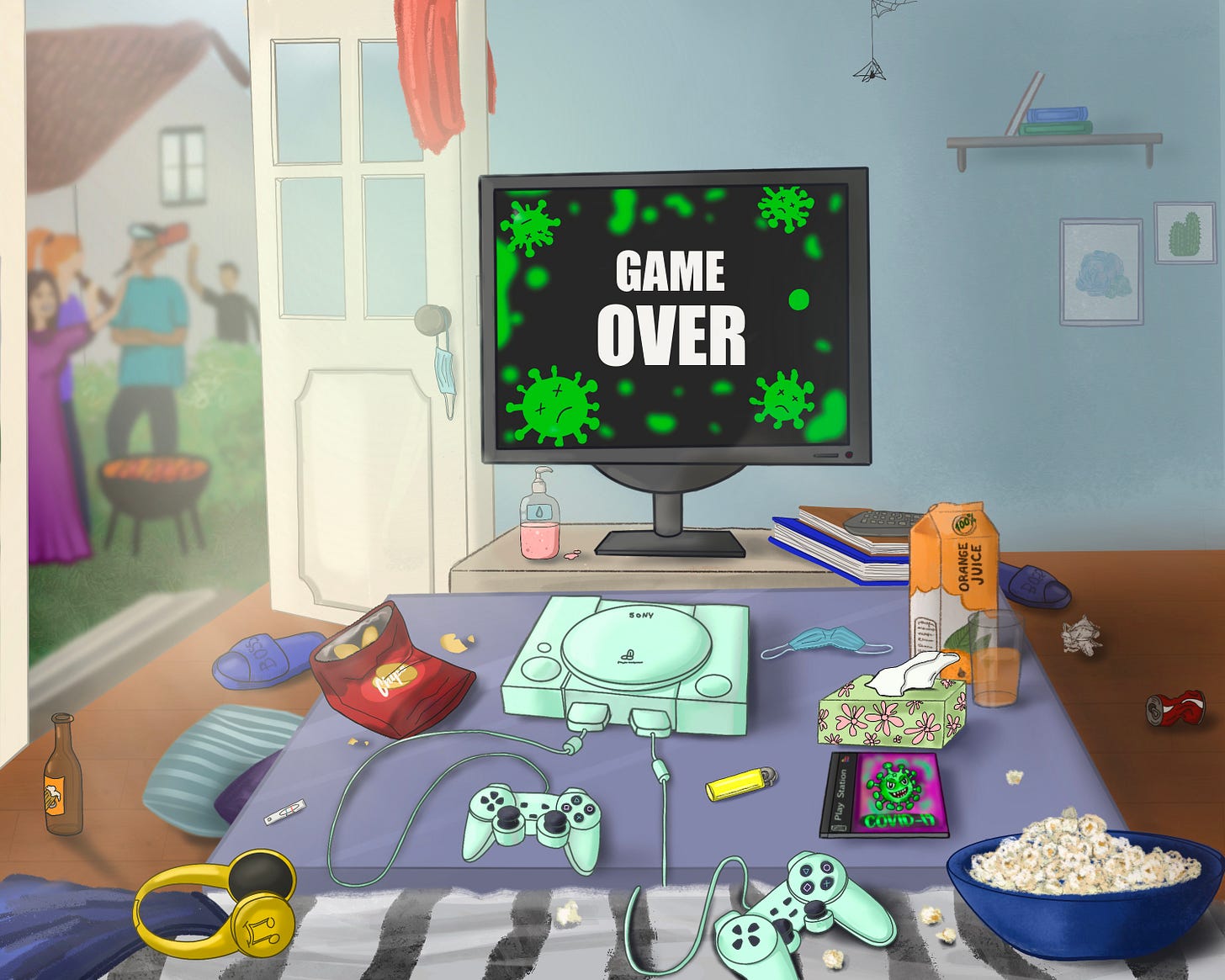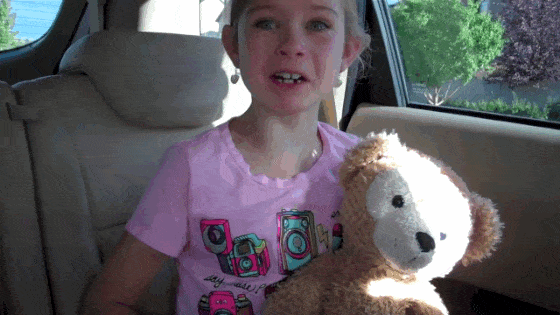Coronavirus: Game Over
It's time to start living again
Summary:
Between Omicron, vaccines, and treatments, the risk of COVID is down by 10x to 1000x.
This Omicron wave is likely to be the last we should be cautious around. As a result, we should officially end the pandemic soon, probably in a month or so, unless some new, pretty unlikely new information appears.
The biggest risk is that you don’t internalize this and keep as usual instead of realizing we’ve entered the end state of COVID. The next few months will be like the next few years. Act accordingly.
This is especially true for governments. They need to know when to stop
We did it. We flattened the curve.
Last month, I wrote in The Omicron Question:
If you haven’t had COVID before, you’re going to get it.
You can only escape it while you lock yourself out. The moment you come back into society, you will get exposed to it. Paradoxically, this can be good.
This is the final battle for COVID. It’s throwing everything it has at us and will overwhelm the world. But in doing so, it might have weakened itself. And it’s attacking at a moment when the world is well-armed with vaccines and prior infections.
In this final battle, many people will die. But they might be few in comparison to what it could have been.
This all hangs on one data point, the Omicron Question: the fatality rate
With vaccines
With previous infection
Without vaccine or previous infection
It will take us a few weeks to get that data. Only when we get that will we be able to tell if Omicron is good or bad.
Hopefully we’ll emerge on the other side of this wave in a world where our immunity to COVID is so strong that we don’t need to worry about it beyond getting our booster shots every now and then.
Now we know.
How fast it spreads has been confirmed: like lightning. You can catch it even with some immunity, you can spread it even asymptomatic.
Between existing immunity and Omicron’s superspreading, the spread is so fast that waves can start going down quickly after kicking in.
And its virulence has been properly estimated now1, at approximately:
Hospitalizations: -50% compared to Delta.
Death: -90% compared to Delta, or ~75% less than the original variant, making Omicron just about 2x as virulent as a normal flu2.
In Simpson’s Paradox vs. Upper Respiratory Tract Hypothesis, I stated that we didn’t know yet whether the lower virulence was due to a milder virus or simply more people immune through vaccines and natural infection. It turns out it was both, and the reduction of virulence is dramatic. Which can now be seen in South Africa:

Add to that the fact that good vaccines reduce fatality rates by ~90%, and that a Paxlovid treatment also reduces fatality rates by ~90%, and COVID’s fatality rate has gone down three orders of magnitude, by 99.9%3.
This makes now COVID more than ten times less lethal than a normal flu4.
Coronavirus: Why You Must Relax Now
In Coronavirus: Why You Must Act Now, I sounded the alarm on COVID.
In Coronavirus: The Hammer and the Dance, I explained what we had to do about it.
Today, in Coronavirus: Game Over, I’d like to explain why this means the end of the pandemic phase, and the beginning of the end(emic) phase.
On the 10th of March 2020, the world had not realized what was coming. It was important to share how what had happened to Italy and Iran was going to happen everywhere else if they didn’t shut down their countries. That proved to be true.
One week later, when I published The Hammer and the Dance, I explained why we needed to apply shutdowns: to buy ourselves time, so we could
Prepare the healthcare system
Learn to do testing and tracing
Produce masks we needed at scale (and other things, like ventilators)
Understand the virus
Understand the cost-benefits of tackling it
Find treatments
Get vaccines
Check, check, check, check, check, check, check.
After the Omicron wave, we’ll be in a world where most people will have some sort of immunity, either through natural infections, vaccines, or both. We now know how to get vaccines fast (we should approve them faster for new variants), and we have treatments too. The value of time for learning has dropped: we know most of what we need to know about it. So the benefits of social measures to stop COVID are much lower.
Meanwhile, the costs of stopping COVID are much higher, because Omicron escapes immunity and is extremely transmissible. It’s much, much harder to stop a COVID wave now than it was two years ago. Look at how China is desperately trying to stop the virus but can’t without drastic lockdowns.
Lower benefits, higher costs: the ROI (return on investment) of tackling COVID with social measures has reversed. And from now on, it’s not going to get any better:
Will we get better treatments and vaccines? Maybe, but the improvements will be marginal. They’re close to as good as we’ll get.
Will its virulence suddenly increase dramatically? Over the long term5, coronaviruses tend to reduce their virulence. Very few do the opposite. So it’s unlikely to happen.
Will it get any easier to stop the virus? Extremely unlikely: it is unlikely to mutate to be less transmissible.
If the benefits of social measures are as low as they’ll ever be, and their costs as high as they’ll ever be, the cost/benefit of fighting COVID won’t change much anymore in the next few years.
So unless a new variant appears with lots of immune escape and higher virulence, we should start relaxing and living our lives the way we want them to.
This is not true for everybody.
Who Can’t Relax Yet
Healthcare workers, emerging economies, immunocompromised people, and kids.
Healthcare Workers
In most of the world, Omicron cases are still going up. Hospitalizations are following. If things are like in South Africa, this wave might be less aggressive than previous ones for healthcare workers. But it’s still in front of us. They need to tackle it—at least those who still have the strength. Luckily, it’s always darker before the dawn. Once this wave is done, natural immunity plus vaccines are likely to be strong enough to prevent subsequent waves from being as big.
Emerging Economies
Emerging economies typically have fewer people vaccinated than mature ones. When Omicron will hit, it will hit hard.
But many of these countries have had dramatic Delta waves. Many of the people who would be infected by Omicron have some Delta protection. That, plus Omicron’s lower virulence, means their hospitalizations and deaths will be lower.
Still higher than in countries with more vaccinations though. And since healthcare systems are less equipped in emerging economies, it might be reasonable to be a bit more cautious.
Immunocompromised People
If vaccines don’t work on you, or if you’re at serious risk of death because of some comorbidities, you can’t relax as much. COVID might get you.
But this is likely to be as true in a month as in a year. So maybe you should wait out this wave, but after it, you might considering living in a few weeks the way you would want to live in a few years.
Immunocompromised people have been in this situation since forever. What has changed is one more virus to protect for and much more knowledge on who is immunocompromised and how to protect themselves from respiratory viruses.
Kids
Most kids are not vaccinated yet, but in many countries, they’re about to be able to. Taking a few more weeks to vaccinate them will give us time to lower their risks of hospitalization, death, and ME/CFS by 90%.
What About Other Unvaccinated People?
At this point, they’re either in emerging economies, kids, or anti-vaxxers. Once all those who can get a vaccine are vaccinated, it’s anti-vaxxers’ prerogative to die from COVID if they want to6.
What About the Rest of Us? Should we relax now?
You might want to remain vigilant for a few weeks while this wave passes. You don’t want to join a full ICU and no available treatment anywhere around you.
Not only that, but whether you have some immunity or not, your risk will go down once this wave ends because everybody around you will have much more immunity, while the prevalence around you will drop, as the great Bob Wachter explains:
The other factor is that production of Paxlovid, Pfizer’s successful treatment for COVID, is still low but ramping up fast. The world won’t have enough of it to treat everybody during this wave, but it is likely to have enough for the next one, at least in mature economies.
So when is this wave going to end?
In South Africa, it took about a month to peak and it appears it will take about another month to end. The UK also took about a month to peak. If this trend is valid for other countries, since Omicron really kicked in in mid-December, we should be done by mid-February.
But after that, we should all prepare for the End Game.
COVID End Game
Most people don’t internalize new information quickly, so let’s call out what is coming.
The world we’re entering is not a continuation of the last two years. You should think about your next few months the way you should think about your next few decades.
This will be counter-intuitive. You’ve been behaving differently for two years. New habits have kicked in. They’re hard to shed.
How to Deal with PCSD
When you see in a TV show scenes with lots of people indoors, do you think “Eww, gross! These guys are spreading germs and they don’t even realize it!”?
When you enter a store, does your hand automatically search your pockets for a mask? Are you scared of how others will judge you if you don’t wear one?
Do you do a disinfecting gel facial after seeing this?

When you meet somebody, are you wondering whether you should fist bump, wave, shake their hands, hug, or even do the European thing, give a few kisses?
When somebody invites you to a party, is your first reaction to ask “Is it indoors?”
When you hear the words “new variant”, do you pick up food for two months and lock yourself up?
If you’ve answered yes to 50% of these or more, you might have PCSD, post-COVID stress disorder7. You should ask yourself: Do I want to be like this for the rest of my life? If the answer is no, that’s good. The first step to solving a problem is realizing you have a problem.
Most phobias can be solved through habituation. This is probably the same. Scared of massive indoor parties? Start joining small outdoors parties. Then a few small indoor parties. Then grow the size of the parties you attend. Feeling frisky? Take a risk and go to the movies without a mask. YOLO. And if you need a safety system, I’m sure there’s some PCSD Anonymous groups organizing around you. Join one. And if none exist, why not creating one?
It’s fine to meet people indoors.
It’s fine to go to parties.
It’s fine to not use a mask. Or to use one. Especially if you’re sick, please.
It’s fine to shake hands, or to do la bise.
When in doubt, maybe do an antigen test and that’s it.
It’s also fine to decide you don’t want to go out for the small risk of catching COVID and dying from it. For consistency, I hope you would have done this before COVID.
The ones I’m most concerned about are not normal people like you and me, though. We’ve learned to manage our risks. I’m concerned about governments.
The Party Is Over, Governments
Most governments were reluctant to use hammers (lockdowns) early on, until they were overwhelmed with cases. Over the months, they learned very slowly to dance (intelligent measures to stop the impact of the virus while not hurting the economy), but they remained pretty hammer-happy. They want to keep dancing even if the party is over. They wield measures against COVID like a favorite toy. But now it’s time to give it away.
Governments were reluctant to use these drastic measures early on because they thought people wouldn’t respect them, and they wouldn’t respect them because they don’t trust the government.
In fact, one of the most powerful tools against COVID (test-trace-isolate) was not used by most Western countries because they didn’t want to encroach on privacy (all the while they were jeopardizing economies, liberty, and lives). They didn’t want to encroach on privacy because they feared citizens would not want them to do it. Citizens are wary of the government because in the past it hasn’t built trust in handling their rights properly.
Governments: now is the time to build trust.
You’ve increased your powers during COVID. If you give them back, and you prepare legislation for the next pandemic, citizens will trust you more next time.
But if you linger with your measures and don’t have a horizon in sight for stopping them, your citizens will lose even more trust in you. So here’s a list of things you should do:
Put a date at which, unless there’s new information, all measures against COVID will be stopped.
Put specific conditions in which measures might come back. These should only happen if a terrible new variant arrives that has both massive immune escape and a much, much higher virulence. If the past is any indication, both of these are very unlikely to happen.
Specifically, don’t apply any more lockdowns. Only very dire situations should justify them, and you should define them in advance.
Stop mandating masks. Let people and businesses decide their own masking policies. Stop them especially outdoors: they were never useful.
Continue vaccination campaigns and making it easy to buy masks or rapid antigen tests.
Accelerate the approval of vaccines against new variants.
Two years ago was the time to act boldly and expand the state. Now is the time to reduce it. Do it, build trust, and next time around they’ll trust you more.
This week in the premium post I’ll explore what kind of endemic state we can expect with COVID. Subscribe if you want to read that.
The Imperial College paper compared Delta and Omicron, and suggests Omicron lowers any hospitalization by ~25% and more serious ones by ~45%, which suggests it reduces deaths by even more.
The Southern California / Kaiser paper suggests a reduction of hospitalizations of 50%, ICU of 75%, and death of 90%. Because they use the same timelines for both Omicron and Delta, that broadly controls for other factors like vaccination rates and rates of previous infection.
Other papers don’t control for things like previous infection, so they are going to be too biased against Delta. This is especially true for the South African paper. The Scottish paper will be less inaccurate since by the time Omicron hit, about 75% of the population had had some vaccine, so the impact of mass natural immunity would be low anyways. The Scottish paper suggested a reduction of hospitalizations of ~60%.
Alpha was ~60% more virulent than the original variant, and Delta was yet again ~60% more virulent than Alpha. A reduction of virulence of ~90% of Omicron vs. Delta broadly puts it at ~75% less virulent than the original variant, which is huge. It would go from an average fatality rate of ~1% in mature economies to ~0.25%, just about twice the virulence of a normal flu.
This is an approximation. I’m sure that there are interactions here, such as Paxlovid might not work as well with people hospitalized despite vaccines, or the fact that some of these don’t behave the same way in immunocompromised people.
These are very broad estimates. But if you take 0.13% as the average fatality rate of the flu in the US in the last 10 years or so, and an underascertainment rate of ~50%, that means an IFR or Infection Fatality Rate of ~0.06%, compared to COVID’s ~1%. But if now it’s 75% less lethal without vaccine, and then vaccines reduce fatality rates by 90% and Paxlovid can again reduce that by 90%, you end up with a fatality rate for COVID including vaccines and treatments of 0.0075%, or 12.5x less than the flu.
The inverse is true for the short term.
Maybe social healthcare systems shouldn’t treat their COVID or their Long COVID though.
Also, there’s an interesting case about the function of vaccinating kids for epidemiological purposes. As the government, I wouldn’t do it, but… why would kids, who can not make decisions, be at the mercy of their parents’ decisions on their life and death? I find the parallels with the abortion debate ethically interesting.
This is not medical advice, in case you were doubting. In fact, this entire section is tongue-in-cheek. It’s time to laugh again, people.








I would like for you to be right... I am so tired of the pandemic. But I fear it's premature to declare game over, for several reasons. 1. As you say, heath workers are still in a crisis stage of the omicron surge. We need to maintain precautions until hospitalizations come down. The trauma hospital here in Seattle is at 120% bed capacity, with cots in hall ways and the ER. Keep masking for at least another few weeks. Many hospitals are on edge of failing. 2. We may be done with the virus, but it's not done with us. We are lucky that even though antibodies from vaxx or infection are less effective against omicron, this variant doesn't do well in the lungs and so doesn't cause the severe respiratory symptoms that cause most fatalities. There is no guarantee that the next variant won't evade antibodies like omi AND cause severe illness like delta. 3. Speaking of variants, as long as 25% of Americans are unvaxxed, and larger proportions in other countries, the virus will continue to find many hosts to infect and generate new variants in. Some of those variants will share omi's ability to evade antibodies and cause breakthrough infections. Until most of the world is vaxxed and regularly boosted, I fear that we will have periodic outbreaks like the past month, regularly disrupting society. 4. Speaking of the unvaxxed, I wish we could write them off as exercising a choice to suffer the consequences of their bad decision. But omi has showed us that their bad choices impact us too. They make up most of the patients in critical care in hospitals and are pushing hospitals to postpone non-covid procedures like cancer, heart, diabetes and elective surgery. People who need treatment are dying because of the feckless of the unvaxxed. Also, a big pool of unvaxxed hosts allows the virus to transmit throughout the entire population, including kids, the elderly, and the immunocompromised. Like it or not, we're all in it together. So as long as a significant part of the population remains unvaxxed, I think it's too early to declare an end to pandemic life and move to a "covid is just another endemic seasonal bug" way of life. Sorry, I really do want to get this over with.
Few support the resumption of anything like “the hammer”. But I am astounded that you appear to have given up on sensible protections like FFP2/N95 masks, restrictions on mixing in confined venues, and proper precautions in schools. Even if omicron is the last significant variant, these will still save thousands of lives, prevent hundreds of thousands of cases of disability, and protect us against the uncertainty of a blood and brain disease they is not yet well understood.